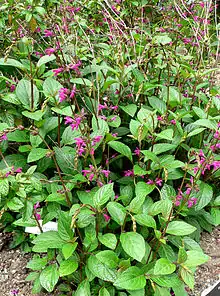Salvia chiapensis
Salvia chiapensis (Chiapas sage) is a herbaceous perennial native to the province of Chiapas, Mexico, growing between 7000 and 9500 feet elevation in cloud forests. It was introduced to horticulture in the 1980s, probably as a result of a collecting trip by the University of California Botanical Garden, Berkeley.
| Salvia chiapensis | |
|---|---|
 | |
| Scientific classification | |
| Kingdom: | Plantae |
| Clade: | Tracheophytes |
| Clade: | Angiosperms |
| Clade: | Eudicots |
| Clade: | Asterids |
| Order: | Lamiales |
| Family: | Lamiaceae |
| Genus: | Salvia |
| Species: | S. chiapensis |
| Binomial name | |
| Salvia chiapensis | |
Chiapas sage grows about 1.5–2 feet (0.46–0.61 m) tall and wide, with several stems growing out of the rootstock. The 3-inch-long (76 mm) and 1.5-inch-wide (38 mm) elliptic-shaped leaves are ivy-green, glossy, and deeply veined, growing widely spaced along the stem. The flowers are bright fuchsia, with 3–6 flowers growing in whorls, widely spaced along the inflorescence. The flower is 0.75 inches (19 mm) long and covered in hairs, with a 0.5-inch-long (13 mm) pea-green calyx.[1]
Notes
- Clebsch, Betsy; Barner, Carol D. (2003). The New Book of Salvias. Timber Press. p. 74. ISBN 978-0-88192-560-9.